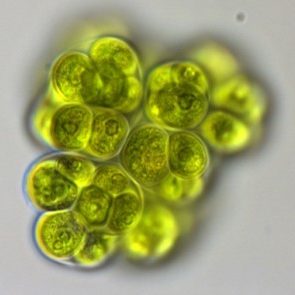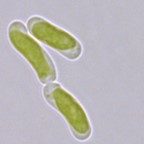AN UNSUSPECTED “OCEAN”
Microalgae are well-known and studied in rivers and lakes, including those from mountain areas. Microalgae are also considered as markers of the pollution of certain sites. More occasionally, their presence is recorded in stagnant water, on tree bark, the fur of animals, but also all kinds of dry surfaces, rocks, etc. Finally, and this is a recent breakthrough, microalgae growing in snow has attracted the attention. Despite the broad distribution of microalgae in all ecosystems, knowledge is fragmented, each environment being explored independently, and no comprehensive view is currently available. When we swim in the ocean or in a stream, the water is transparent to us, but we know that it is alive, of a microscopic life, including microalgae (which form phytoplankton), allowing animals (which form zooplankton) to develop.
In the same way :
microbial communities that inhabit all environments include microalgae,
the snow is aliveand populated with microalgae.
It is a sort of “ocean” at our door that the ALPALGA project sets out to explore.
WHY STUDY MICROALGAE?
Why explore the biodiversity of microalgae and seek to understand their biology?
Photosynthesis allows microalgae to capture atmospheric CO2. As a result, algae are part of the primary producers, who transform carbon dioxide into organic matter, which is the basis of a whole nutritional network of fungi, bacteria, small animals, etc., allowing them to develop. They help to form the basis of the microbial ecosystems of soils, water ponds, lakes, rivers, snow, ice, etc. These microbial communities stabilize their environments and are essential for the development of larger organisms.
Current climate change is accompanied by an increase in the CO2 content of the atmosphere: it is therefore expected that certain microalgae respond positively to this increase, behaving as markers of climate change. Exploring biodiversity allows, among other things, to map species or groups of microalgae, and to follow them over the seasons and years. We will combine field studies and laboratory experiments to understand how certain species are indeed favored by the increase in atmospheric CO2.
The proliferation of certain species is not without effect on the general equilibrium of ecosystems. Microalgae have been shown to accelerate the melting of snow and glaciers. They therefore also behave as actors in the striking environmental changes affecting the Alpine massifs. We will study these phenomena in the field, and will seek to understand in the laboratory the impact of all the environmental factors, still unknown to this day, which cause this proliferation of microalgae in the snow.
THE DIFFICULT CLASSIFICATION OF MICROALGAE
There are several branches of life that include unicellular organisms capable of photosynthesis. All of these very diverse organisms are called microalgae because they share features such as a small size, the presence of photosynthetic pigments, the capacity to grow by capturing atmospheric CO2. However, there is not a single group that would bring together all microalgae: several groups appeared at different times in evolution.
The most ancestral group, known as the cyanobacteria, is composed of cells of very simple structures, containing photosynthetic membranes. Cyanobacteria formerly called « blue algae » are sometimes considered a group apart from microalgae, in strict meaning.
Through an initial process called a “primary endosymbiosis”, a cyanobacterium has been “engulfed” within a cell of another origin, leading to the emergence of a novel cell structure giving rise to several major lineages of algae including green algae (Chlorophyta) and red algae (Rhodophyta).
Later, at several times in evolution, other “engulfments” occurred (called secondary endosymbiosis events), leading to organisms of a higher level of complexity, including the majority of marine microalgae, such as diatoms.
In terrestrial environments, the major group of microalgae populating soils, the surface of rocks, the rivers, snow, etc., is made up of green algae. This is the group studied in the ALPALGA project.





